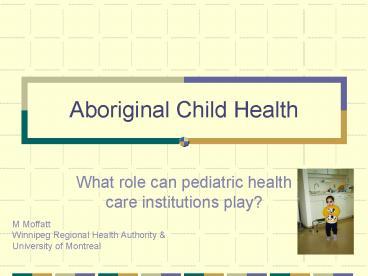Aboriginal Child Health PowerPoint PPT Presentation
1 / 26
Title: Aboriginal Child Health
1
Aboriginal Child Health
- What role can pediatric health care institutions
play?
M Moffatt Winnipeg Regional Health Authority
University of Montreal
2
Outline
- Identify aboriginal children
- Health indicators
- Current system(s) of delivery
- Likely future trends
- Quality health care for Aboriginal children
- Where do CAPHC institutions fit in?
3
Who and where are aboriginal children?
- 1 million Aboriginal people (gt 40 children)
- First Nation (62)
- On reserve
- Off reserve
- gt50 now live in urban areas
- Status vs. non status
- Inuit (5)
- Métis (32)
4
(No Transcript)
5
Urban Aboriginal children
2 groups
Educated, employed parents
Poorly educated, Often unemployed parents
Inner city, Ghetto, Poverty, ? morbidity
6
Profile of urban Aboriginal people
Source Statistics Canada. Aboriginal Peoples
Survey 2001
7
Health status
8
Regions with gt19 Aboriginal population
- PYLL 50 greater
Source Allard et al. Health Reports 20041551-60
9
PYLL by cause
10
Diabetes Mellitus Type II new cases in Manitoba
11
Canadian BMI data
- Young 1990 Mb and NW Ont.. - adults
- BMIgt30 - 27.3
- Young, Dean et al 1999 (unpublished)- Mb children
- BMI gt 95 - girls 40
- boys 34
- BMI predictive of diabetes
- Hanley 2000 NW Ont BMI gt 85 girls 34, boys 28
12
Child Hunger
- 16 Aboriginal off-reserve families vs. 3.9
others
Source McIntyre L et al. CMAJ 2000163961
13
Social Determinants or health care?
- Poverty, lack of power and control, low education
- There seems no excuse for complacency we ought
to speak out. - But
- The high levels of morbidity make it unethical
not to provide the best possible care. - Health care has a small (but measurable)effect
14
Usual existing delivery system
- ON-reserve/remote
- Federal (except Quebec and territories)
- Nurse clinician model
- GP support
- Some areas tied into systems of specialist
support - On-reserve not remote
- PH services in community
- Use adjacent communities for acute and primary
care - Urban
- Use existing services
15
Gaps in current system
- Assumption if services are close, access occurs.
Not valid - Remote/rural
- Staff turnover/human resources shortage
- limited or no access to allied health
- Federal-provincial wrangling
- Handicapped children
- Lack of community control
16
Falling between the cracks
Case 1 An 11 month old girl with a birth
defect of her heart, corrected surgically,
remains on a respirator has a tracheotomy and is
fed through GT tube. Brain is normal no
cognitive impairment expected. In hospital all
her life, now ready for discharge. Needs a
medical foster home and parents, who remain
involved, agree.Although a good home is found,
placement has been denied by the First Nations
Child and Family Services Agency, on the strength
of a directive indicating that INAC and FNIHB
will not fund the costs. Parents faced with the
option of giving up rights to the child so she
becomes a ward of the province. Ultimately this
child stays in hospital for 14 months before the
issues are resolved.
Case 2 A child with a complex genetic disorder
who is also severely developmentally delayed .
Languished in hospital for 18 months after ready
for discharge. VPA held up because no one would
agree to pay the costs.
17
Issues
- Federal? Provincial downloading
- Piece-meal approach to funding
- Uninsured services (often require individual item
approval) - Lack of a patient-centred approach
- First Nations agencies caught in between
18
Characteristics of a good health system
- Access 24/7
- Continuity
- Seamless integration
- Full range of services
- Patient-centred
- Evidence-based
- anticipatory
19
Evolving Aboriginal health system
- Nunavut and NT
- Quebec
- Individual Community examples of excellence
- Eskasoni
- Kahnawake
- Urban Aboriginal systems
Lemchuk-Favel and Jock J Aboriginal Health Vol. 1
Jan 2004
20
Community-controlled aboriginal health services
characteristics
- Self-empowerment
- Holistic approach
- Synergy of traditional and western
- Primary care
- Collaboration with provincial services
- Integrated
- Administrative reform
Lemchuk-Favel and Jock J Aboriginal Health Vol. 1
Jan 2004
21
Community control and health
22
Effectiveness of Specialist outreach visits
- Cochrane review (Gruen et al)
- Some evidence that outreach improves access and
quality, particularly if done in a multi-faceted
manner - Main evidence from urban non-disadvantaged
populations
23
Highest premature mortality
24
CAPHC and Aboriginal health
- Most of tertiary resources for children
- Unique knowledge base
- Telehealth technology
- Networks
- RHAs
- formal
- Multiply handicapped children remain in our
institutions
25
What can we do?
- Support Aboriginal control of services
- Develop partnerships with aboriginal groups
- Provide new, or link with existing outreach
programs - Insist that these be multi-faceted
- Think outside the box!
- Make services client-centred
- Connect with evolving primary care
- Provide interpreter services
26
What can we do?
- Foster cultural awareness
- Aboriginal employment
- zero tolerance for prejudice
- Take a stand on repatriation of multiply
handicapped children - Offer services by telehealth
- But must link with existing care system
- Think outside the box
- Lobby for social and political change

